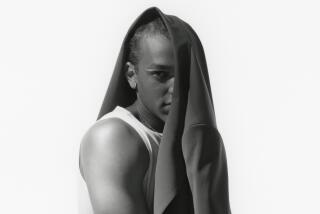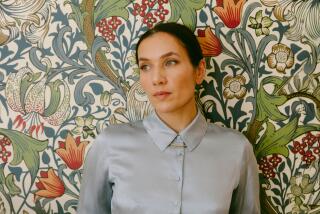District of Predictability
- Share via
WASHINGTON — As quickly as the rumor that Hillary Rodham Clinton would wear a Giorgio Armani gown to the Inaugural Ball buzzed around town last week, it died. The news was hardly worth repeating, since anyone who knows anything about fashion in the nation’s capital would respond: fat chance.
Style in Washington hangs from the twin pillars of conservatism and political correctness. The likelihood of the first lady stepping out in a dress designed by a European would be as remote as her wearing a transparent chiffon slip dress hot off the New York runway under a baby seal coat. In this most political of cities, what a woman wears must be politic.
So Hillary Clinton chose an inaugural suit and gown for today’s festivities created by Dominican-born New Yorker Oscar de la Renta. For the last inauguration, she picked an unknown Arkansas designer. Both choices reflect her desire to please a constituency.
In Los Angeles, women fill their closets with an eye toward satisfying only themselves. How they dress is often ruled by the laws of heterosexual attraction. In Washington, the need for propriety dominates.
“Looking proper is incredibly important, and is part of every fashion decision that’s made,” says Jason Weisenfeld, who worked in the White House social office during the first Clinton administration and is now director of public relations for Barneys New York. “A lot of Washington women hesitate to cross the line between what’s socially acceptable and what’s hip. It’s different in New York or Los Angeles. In those cities people are praised for an aggressive fashion sense. In Washington, women don’t have that same luxury. They’re very mindful of the negative effect their dress can have on their career or on their husband’s political acceptance.”
No less a modern fashion icon than Courtney Love has admitted, “I always end up wondering, ‘What are the cultural implications of my wearing this dress?’ ” If she thinks about the ramifications of her sartorial moods, she should walk a mile in Secretary of State designate Madeleine Albright’s Hush Puppies.
The whole world is ready to scold Washington women for fashion missteps. Hillary Clinton was castigated for wearing pants during a televised interview with Barbara Walters. “You can tell someone’s age these days by whether she wears pants or not,” says one woman who never wears trousers to her Capitol Hill office. “The dividing line is 32.”
The accepted look here is traditional, colorful, modest and often preppy. Elizabeth Dole’s campaign wardrobe was standard issue for a political wife--feminine, flattering, proper and not too flashy. The Republican cloth coat ethic that flourished during the Eisenhower and Nixon years, driven by distaste for anything showy, has had lasting bipartisan appeal. Barbara Bush and Roslyn Carter never let their clothes grab the spotlight. True to the Washington style canon, they were innocuous and predictable.
“Politics, by its nature, is by and for the people, and when you’re involved in it, you shouldn’t distance yourself too far in your image or your style from the conventional. It’s not an asset to do that,” says Gale Hayman, co-founder of Giorgio, Beverly Hills and author of the style guide “How Do I Look?” (Random House, 1996). Hayman, a former Southern Californian, now divides her time between New York and Washington. “Washington is about power. It’s anti-politics to be too stylish. A woman policymaker can’t go on television in the latest Prada outfit,” she says. “She’d look silly.”
About as wacky as Nancy Reagan looked in the black satin knickers she wore to an official dinner at the American ambassador’s residence in Paris in 1982. A sophisticated woman of taste and style, Reagan was excoriated for liking beautiful things, from costly new White House china to the sort of designer duds that were normal among her social circle. Only a song-and-dance performance at that year’s Gridiron Club roast in which she mocked her own clotheshorse reputation could redeem her.
Had she lived in an age of full disclosure, Jackie Kennedy would have needed a similar image adjustment. Details of her whopping wardrobe expenditures were kept as covered-up as her husband’s infidelities. She was so enamored of Parisian designers that she directed American Oleg Cassini to copy their creations, knowing that with his label wearing them would be acceptable. And by using one designer, she gained greater control over leaks about costs.
The object is still to not be conspicuous. The assumption that a woman who cares about her appearance is shallow lives on, as if an interest in style and concern for weightier issues were mutually exclusive.
“At a cocktail party, people know they’re not supposed to be talking about fashion,” says Patti Cumming, regional director of public relations for Bloomingdale’s, which has stores in neighboring Virginia and Maryland. “They want to convey that the business of the day is what they’re focused on, something that might change the world or change policy.”
Bloomingdale’s personal shopping service gets more use in the Washington area than elsewhere in the country, Cummings says. “Shopping is not a hobby in Washington. There isn’t a lot of time for it.”
So the staid state of dress that many men here lament may be partly blamed on busy schedules. Penny Rostrow, deputy assistant secretary in the Department of the Treasury says, “Conformity and professionalism are more highly prized than creativity. Getting dressed is a less creative process here than other places. That can be an advantage when you’re working 90-hour weeks.”
Women often go straight from their offices to cocktail parties or dinners that are more business than social. They prize low-maintenance clothes whose chief virtue is practicality. “So many people are on television and in front of cameras in Washington that good grooming is essential, and you do see it,” Hayman says. “You see clothes that fit, that are well-pressed. You don’t see sloppiness.”
With little time to shop or even to think about her wardrobe, and the threat of social censure if she takes fashion risks, a universally acceptable uniform would be a blessing. In fact, the St. John suit, a knit jacket and matching skirt, has become an unofficial uniform. The Chanel wannabe suits, typically adorned with gold buttons, are proper, packable and versatile enough to serve for day or evening. “I lived in a black St. John knit suit when I worked for the office of protocol,” says Southern Californian Tina Thompson, a wholesome blond in her early 30s. Now given to sleek pantsuits, Thompson gave her trusty St. John to her mother when she returned to the West. “I thought, ‘I’ll never wear that again.’ ”
Among women who can afford it, Chanel is also popular. But St. John is above reproach because the line of knits is made in America (actually, in Southern California). Even a wealthy woman who came to a posting with a Chanel wardrobe might draw criticism for her expensive taste. “Any woman who spent as much money on her clothes as Warren Christopher spends on his would get a lot of heat,” a Washington insider says. (And no one complained that Turnbull & Asser, the former Secretary of State’s favorite tailor, isn’t American.)
If the good little suit provides a daytime solution for Washington women, fashion choices for formal occasions can be more problematic, particularly in a season when designers are offering so much that is sheer, bare and sexy. Princess Diana, once a political wife of sorts, appeared at a black-tie dinner in New York last month wearing a navy slip dress that might have been mistaken for lingerie. Would she have been so adventurous if she were still on the arm of the future king of England?
At a recent Washington trunk show of the spring collection by Cerruti 1881, young women shied away from anything provocative. “These were good-looking women married to successful men in politics or business,” says Cerruti spokeswoman Margaret Muldoon. “If a dress was a little open in the front, they’d ask, ‘How can we close this up so there isn’t any skin showing?’ That day, 150 women showed up, and with the exception of one who was dressed head to toe in a Chanel pantsuit, they were all wearing skirts.”
It is curious that in a city where women have won a hard-fought battle to participate in the political process, they have sacrificed the right to self-expression in what they wear. Humor, seductiveness, playfulness--so many of the elements women who enjoy fashion appreciate--are hard to find in the center of political power. When it comes to style, in the home of the brave and the land of the free, women can’t afford to be either.






